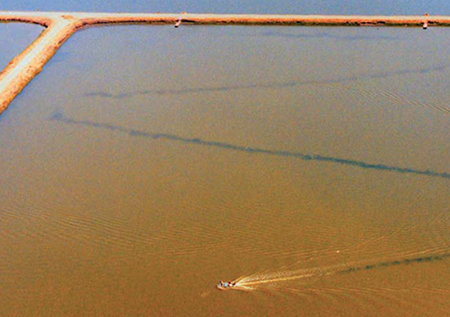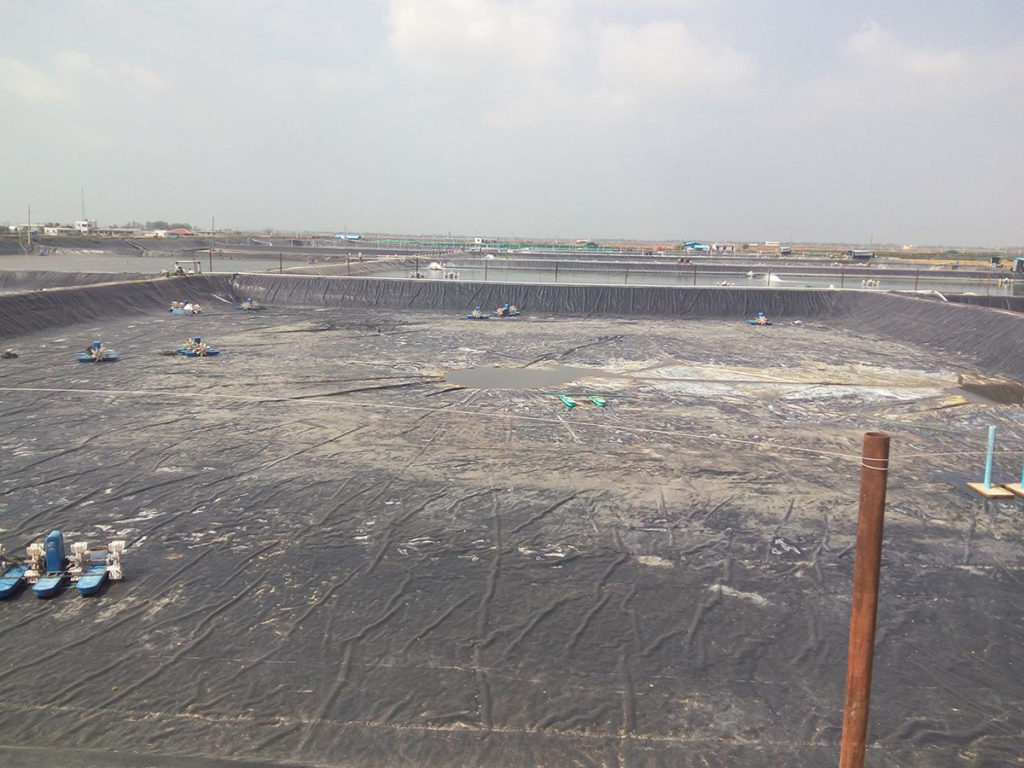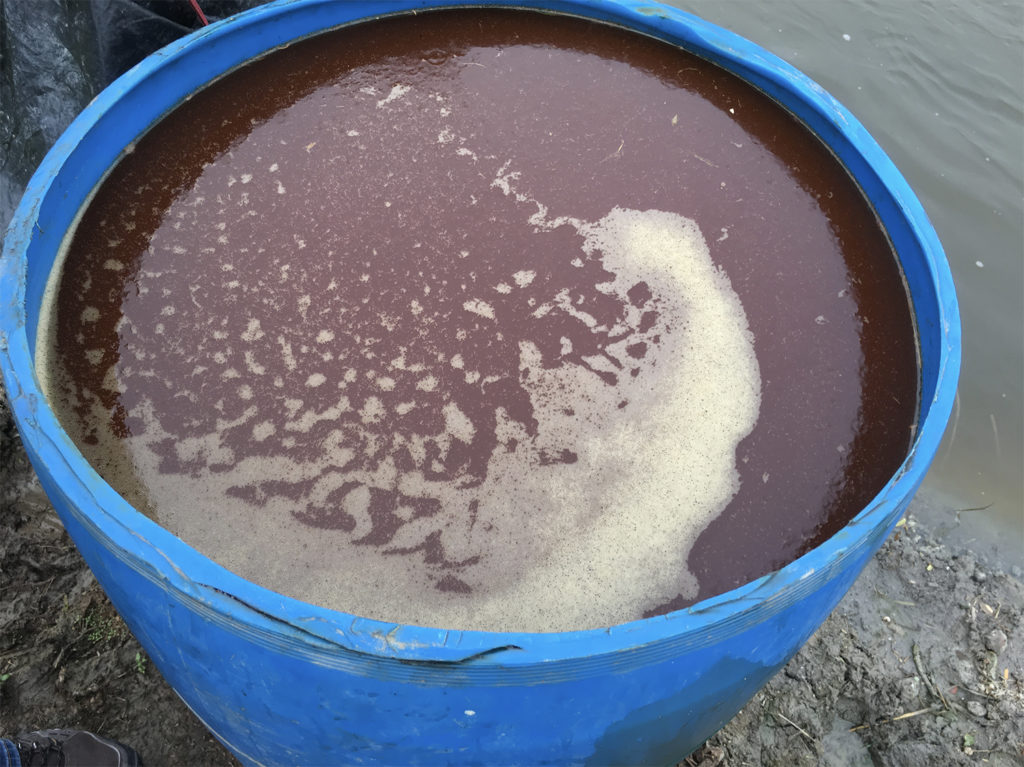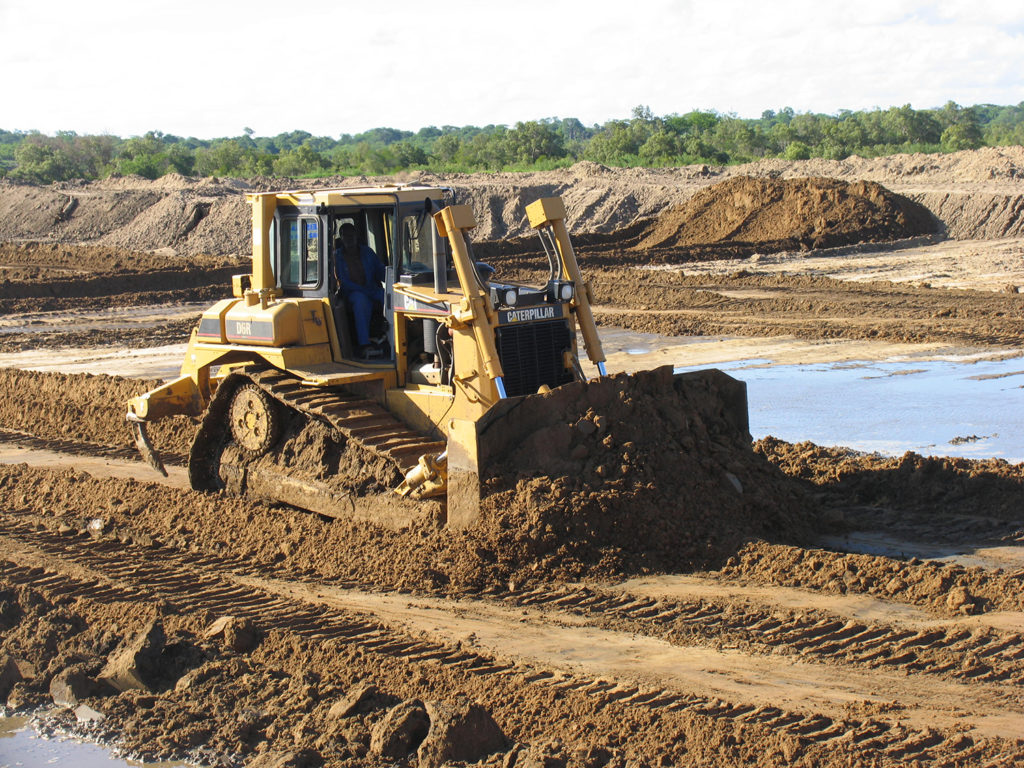Sludge is harmful, causing anaerobic zones in shrimp ponds
The rapid expansion of shrimp aquaculture has lead to problems such as deterioration of pond conditions and disease outbreaks. Excess nutrients from overfeeding and nutrient imbalance in feeds result in sludge that accumulates on pond bottoms. Excess nutrients can also affect surrounding environments. Both the deteriorated ponds and surrounding environment can become breeding grounds for disease agents that endanger the health of cultured shrimp.
Sludge rich in nutrients results from the growth and death of microorganisms that live in the shrimp environment and from uneaten feed and feces. The combination of anaerobic conditions and high nutrient level creates an environment that is ideal for the proliferation of microorganisms that can be harmful to shrimp, either directly as pathogens or indirectly by producing toxic compounds.
Anaerobic zones result when the demand for oxygen exceeds its availability. It is practically impossible to have a 100 percent aerobic aquaculture environment. Macro- and microanaerobic zones are common, even when the level of dissolved oxygen (DO) in the water is high.
For example, anaerobic conditions can develop inside most biofilms, which are the slimy layers of microorganisms that adhere to solid surfaces. With high organic matter, oxygen can penetrate only the top 30 to 50 μm of biofilms, which in an aquaculture environment commonly reach a total thickness of hundreds of μm.
To improve the health of aquaculture systems, one should strive to limit the number of the potential anaerobic sites, making sure that high levels of DO are maintained at all times. High DO levels enable microbial population in the water to eliminate toxic compounds that are formed anaerobically, thus minimizing the negative effects of anaerobic sludge.
Microbes and oxygen
Microorganisms are divided into three groups, based on their requirement for free oxygen. Facultative-anaerobic microorganisms can grow and reproduce either with or without the presence of oxygen. They make up the majority of the microorganisms that live in shrimp ponds. Aerobic microorganisms require oxygen for their growth and reproduction, and are common in the water column of the shrimp pond. Anaerobic microorganisms cannot grow and reproduce in the presence of oxygen. They are present mostly in the anaerobic zones and pockets of the shrimp pond.
Production of harmful compounds
Anaerobic microorganisms consume organic matter without the utilization of free oxygen. They derive energy from the reduction of inorganic oxidized compounds such as nitrate (NO3 -) or sulfate (SO4 =), resulting in products that are not fully oxidized, such as alcohols, ketones, and organic acids. Additionally, microbial anaerobic processes can produce several compounds that are highly toxic to the cultured aquatic animals, such as ammonia, nitrite, and hydrogen sulfide (Table 1).
Horowitz, Anaerobic processes of nitrogen and sulfur, Table 1
| Process | Starting Material | Product | Effect on Shrimp |
|---|---|---|---|
| Denitrification | Nitrate (NO3-) | Nitrogen gas (N2) Nitrite (NO2-) | Positive Negative |
| Nitrate Respiration | Nitrate | Nitrite Ammonia (NH3) | Negative Negative |
| Sulfur Reduction | SOx, Sulfur | Hydrogen Sulfide (H2S) | Negative |

The anaerobic conversion of nitrate to nitrite and ammonia is harmful, as increased levels of these compounds cause stress to the shrimp, weaken their immune system, lead to disease, and at high levels may result in shrimp mortality. Hydrogen sulfide is a general biocide that affects the internal oxygen uptake mechanism of cells by binding to heavy metal groups in the cytochrome system. Since it negatively affects respiration in animals, at sub-lethal concentrations it is likely to weaken the immune system of the shrimp and render them more susceptible to disease. Effect of DO and Sludge On Pathogenic Microorganisms The importance of maintaining high DO levels in the water goes beyond the immediate survival of the shrimp. At low DO, the shrimp are stressed, do not digest food efficiently, and are more susceptible to disease.
A high DO level will shift the make-up of the microbial population in favor of the aerobes. Pathogenic microorganisms are usually anaerobic or facultative anaerobic, as they have to live and survive within the shrimp body, an environment poor in oxygen. Thus, shifting the water environment condition to high in DO will favor the non-pathogenic portion of the microbial population.
In contrast, the sludge environment favors the proliferation of pathogenic microorganisms, offering protection from predation. When the sludge is disturbed – for example, by boats or by workers moving inside ponds (Fig. 1) – these microorganisms are temporarily suspended in a cloud of toxic and oxygen-demanding compounds from the sludge. While suspended, both toxic compounds and pathogens are more likely to harm the shrimp.
The negative effect of sludge on shrimp is more pronounced in the presence of viruses, such as WSSV, as shrimp that are infected by pathogenic or opportunistic bacteria are considerably more susceptible to viral infections. Thus, by increasing DO levels and reducing sludge accumulation, the numbers of pathogenic and opportunistic bacteria in the aquaculture environment are reduced and the incidence of viral disease should be lower.
Management practices for sludge reduction
Following are suggested practices for reducing sludge in shrimp ponds:
- Keep DO level in the water high at all times during growth.
- Scrape and remove sludge from ponds between growth cycles.
- It is preferable to slightly underfeed the shrimp, rather than overfeed.
- If supplemental aeration is used, place aerators so they concentrate sludge in a small area of the pond.
- If a high amount of air is supplied (like in more intensive systems), it is probably better to suspend the sludge at all times, preventing its accumulation at the bottom and making it available as food to the shrimp in the form of microbial flocs.
(Editor’s Note: This article was originally published in the December 2000 print edition of the Global Aquaculture Advocate.)
Now that you've reached the end of the article ...
… please consider supporting GSA’s mission to advance responsible seafood practices through education, advocacy and third-party assurances. The Advocate aims to document the evolution of responsible seafood practices and share the expansive knowledge of our vast network of contributors.
By becoming a Global Seafood Alliance member, you’re ensuring that all of the pre-competitive work we do through member benefits, resources and events can continue. Individual membership costs just $50 a year.
Not a GSA member? Join us.
Authors
-
Ami Horowitz, Ph.D.
UPAH Tech, Inc.
Shaker Heights, Ohio USA[109,111,99,46,111,111,104,97,121,64,104,99,101,116,104,97,112,117]
-
Sarah Horowitz, Ph.D.
UPAH Tech, Inc.
Shaker Heights, Ohio USA[109,111,99,46,111,111,104,97,121,64,104,99,101,116,104,97,112,117]
Tagged With
Related Posts

Responsibility
A look at various intensive shrimp farming systems in Asia
The impact of diseases led some Asian shrimp farming countries to develop biofloc and recirculation aquaculture system (RAS) production technologies. Treating incoming water for culture operations and wastewater treatment are biosecurity measures for disease prevention and control.

Responsibility
Appraising pond liners for shrimp culture
The use of plastic-lined ponds by shrimp farmers can significantly improve production efficiency, support more production cycles per year, and higher mechanical aeration rates and stocking densities. The capital cost of lining ponds can be very significant, so a thorough feasibility analysis is recommended when considering this production tool.

Responsibility
Bacterial amendments in shrimp grow-out ponds
Pond microbial communities are a critical and often overlooked component of aquaculture ecosystems. Bacterial amendments like probiotics provide significant support to shrimp farmers around the world.

Responsibility
Management of non-hazardous solid waste in shrimp farms
Shrimp farms generate non-hazardous solid waste. Use of a sanitary trench helps comply with environmental legislation, improves biosecurity and minimizes contamination risks.


